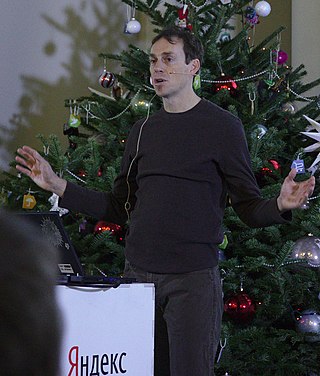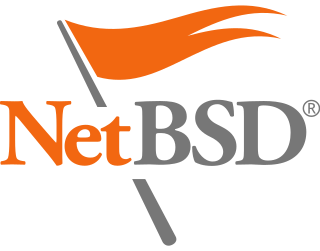
MINIX is a Unix-like operating system based on a microkernel architecture. Since version 2.0, it has been Portable Operating System Interface (POSIX) compliant.

vi is a screen-oriented text editor originally created for the Unix operating system. The portable subset of the behavior of vi and programs based on it, and the ex editor language supported within these programs, is described by the Single Unix Specification and POSIX.

Theo de Raadt is a South African-born software engineer who lives in Calgary, Alberta, Canada. He is the founder and leader of the OpenBSD and OpenSSH projects and was also a founding member of NetBSD. In 2004, De Raadt won the Free Software Award for his work on OpenBSD and OpenSSH.
USL v. BSDi was a lawsuit brought in the United States in 1992 by Unix System Laboratories against Berkeley Software Design, Inc and the Regents of the University of California over intellectual property related to the Unix operating system; a culmination of the Unix wars. The case was settled out of court in 1994 after the judge expressed doubt in the validity of USL's intellectual property, with Novell and the University agreeing not to litigate further over the Berkeley Software Distribution (BSD).

Unix System V is one of the first commercial versions of the Unix operating system. It was originally developed by AT&T and first released in 1983. Four major versions of System V were released, numbered 1, 2, 3, and 4. System V Release 4 (SVR4) was commercially the most successful version, being the result of an effort, marketed as Unix System Unification, which solicited the collaboration of the major Unix vendors. It was the source of several common commercial Unix features. System V is sometimes abbreviated to SysV.
BSD/OS is a discontinued proprietary version of the BSD operating system developed by Berkeley Software Design, Inc. (BSDi).

Berkeley Software Design, Inc., was a corporation which developed, sold licenses for, and supported BSD/OS, a commercial and partially proprietary variant of the BSD Unix operating system for PC compatible computer systems. The name was chosen for its similarity to "Berkeley Software Distribution" the source of its primary product.
William Frederick Jolitz, commonly known as Bill Jolitz, was an American software engineer best known for developing the 386BSD operating system from 1989 to 1994 along with his wife Lynne Jolitz.

The history of Unix dates back to the mid-1960s, when the Massachusetts Institute of Technology, AT&T Bell Labs, and General Electric were jointly developing an experimental time-sharing operating system called Multics for the GE-645 mainframe. Multics introduced many innovations, but also had many problems. Bell Labs, frustrated by the size and complexity of Multics but not its aims, slowly pulled out of the project. Their last researchers to leave Multics – among them Ken Thompson, Dennis Ritchie, Doug McIlroy, and Joe Ossanna – decided to redo the work, but on a much smaller scale.
Lynne Greer Jolitz is a figure in free software and founder of many startups in Silicon Valley. Together with her husband William, she created 386BSD, the first open-source Unix-based operating system for personal computers to be distributed over the Internet.

The Tanenbaum–Torvalds debate was a written debate between Andrew S. Tanenbaum and Linus Torvalds, regarding the Linux kernel and kernel architecture in general. Tanenbaum, the creator of Minix, began the debate in 1992 on the Usenet discussion group comp.os.minix, arguing that microkernels are superior to monolithic kernels and therefore Linux was, even in 1992, obsolete. The debate has sometimes been considered a flame war.
In BSD-derived computer operating systems and in related operating systems such as SunOS, a disklabel is a record stored on a data storage device such as a hard disk that contains information about the location of the partitions on the disk. Disklabels were introduced in the 4.3BSD-Tahoe release. Disklabels are usually edited using the disklabel utility. In later versions of FreeBSD, this was renamed as bsdlabel.

FreeBSD is a free and open-source Unix-like operating system descended from the Berkeley Software Distribution (BSD). The first version of FreeBSD was released in 1993 developed from 386BSD and the current version runs on x86, ARM, PowerPC and RISC-V processors. The project is supported and promoted by the FreeBSD Foundation.

The Berkeley Software Distribution or Berkeley Standard Distribution (BSD) is a discontinued operating system based on Research Unix, developed and distributed by the Computer Systems Research Group (CSRG) at the University of California, Berkeley. The term "BSD" commonly refers to its open-source descendants, including FreeBSD, OpenBSD, NetBSD, and DragonFly BSD.

Unix is a family of multitasking, multi-user computer operating systems that derive from the original AT&T Unix, whose development started in 1969 at the Bell Labs research center by Ken Thompson, Dennis Ritchie, and others.

NetBSD is a free and open-source Unix operating system based on the Berkeley Software Distribution (BSD). It was the first open-source BSD descendant officially released after 386BSD was forked. It continues to be actively developed and is available for many platforms, including servers, desktops, handheld devices, and embedded systems.
Michael J. (Mike) Karels is an American software engineer and one of the key people in history of BSD UNIX.

NextBSD was an operating system initially based on the trunk version of FreeBSD as of August 2015. It is a fork of FreeBSD which implements new features developed on branches but not yet implemented in FreeBSD. As of 2019 the website seems defunct, and the later commits on GitHub date from October 2019. The Wayback Machine captures of the website after 2016-12-15 are domain squatter pages and as of 2021-03-17 the site is redirecting to a fake "Apple Support" page.
The History of the Berkeley Software Distribution begins in the 1970s.













